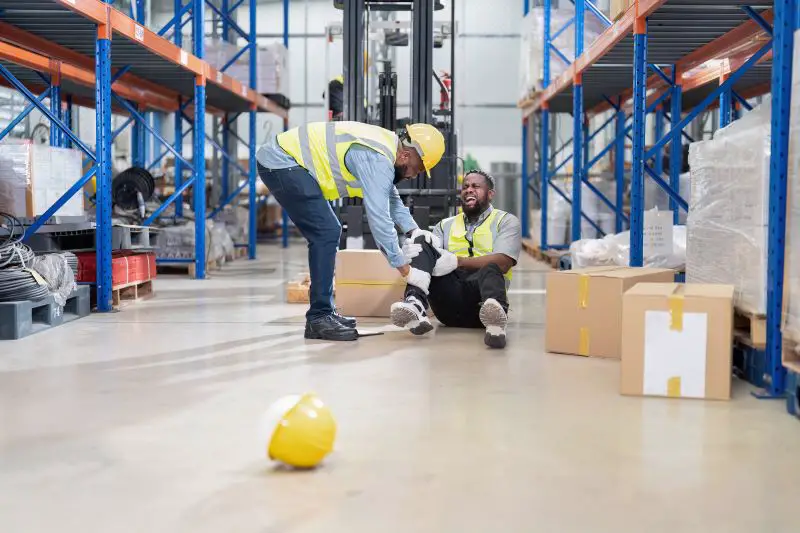Click here to get this post in PDF
Workplace injuries can happen in any industry, in workplaces ranging from offices to construction sites, and they can affect anyone, regardless of experience or role. Many of these injuries are preventable with the right precautions and a focus on safety. By recognising the most common types of workplace accidents and understanding how they occur, both employers and employees can take steps to minimise risks and create safer working environments.
Here, we look at ten of the most frequent workplace injuries and provide practical advice on how to avoid them, helping to reduce the chances of harm and enabling everyone to work confidently and safely.
Slips, Trips and Falls
Slips, trips and falls are among the most common workplace accidents, often resulting from wet floors, uneven surfaces or items left in walkways. These incidents can lead to anything from minor bruises to serious injuries like broken bones or head trauma.
How to avoid them
- Keep floors clean and dry by promptly addressing spills or leaks.
- Use non-slip mats in areas prone to moisture, such as entrances or kitchens.
- Ensure walkways are clear of clutter, cables or loose materials.
- Mark hazards like uneven flooring or steps with clear signs or tape.
- Encourage employees to wear appropriate footwear designed for the work environment.
Muscle Strains
Muscle strains are common in workplaces where lifting, pushing or pulling heavy objects is a regular task. These injuries often occur when workers use improper techniques or overexert themselves, leading to pain, reduced mobility or even long-term damage.
How to avoid them
- Train employees on proper lifting techniques, such as bending at the knees and keeping the back straight.
- Provide lifting aids like trolleys, hoists or pallet jacks to reduce physical strain.
- Encourage workers to assess the weight of an item before attempting to lift it and seek help if needed.
- Implement regular breaks for physically demanding tasks to avoid fatigue.
- Arrange workstations to minimise unnecessary bending, reaching or twisting.
Impact Injuries
Impact injuries occur when workers are struck by falling objects, moving equipment or collisions with vehicles within the workplace. These injuries can range from bruises and minor cuts to more severe trauma like fractures or head injuries. They are particularly common in busy environments such as warehouses, construction sites or factories.
How to avoid them
- Store tools, materials and equipment securely, particularly at height, to prevent items from falling.
- Install barriers or designated pathways to separate pedestrians from vehicles and machinery.
- Provide workers with appropriate personal protective equipment (PPE), such as hard hats and steel-toe boots.
- Regularly inspect and maintain equipment to ensure it operates safely and correctly.
- Train employees to remain alert in high-traffic areas and follow workplace safety protocols.
Repetitive Strain Injuries
Repetitive strain injuries (RSIs) develop from performing the same movements over time without variation, often in tasks involving typing, using tools or operating machinery. Poor posture or improperly designed workstations can also contribute to these injuries. RSIs typically cause discomfort, stiffness or long-term pain in muscles, tendons and nerves.
How to avoid them
- Provide ergonomic workstations that support proper posture, including adjustable chairs, desks and monitor stands.
- Train workers on correct posture and body positioning for their specific tasks.
- Encourage workers to take regular breaks to stretch and rest muscles, especially during repetitive activities.
- Rotate tasks among employees to reduce prolonged repetition of the same motions.
- Offer wrist supports, ergonomic tools or other equipment designed to reduce strain.
Cuts and Lacerations
Cuts and lacerations are common in workplaces where sharp tools, machinery or materials are used. These injuries can occur from improper handling, damaged equipment or lack of attention during tasks. Depending on the severity, they can range from minor scrapes to deep wounds requiring medical treatment.
How to avoid them
- Provide employees with appropriate training on how to handle tools, machinery and sharp materials safely.
- Maintain all cutting tools and equipment carefully and keep blades sharp to avoid slips or snags.
- Supply PPE such as cut-resistant gloves and safety clothing where necessary.
- Establish clear procedures for storing sharp objects securely when not in use.
- Encourage workers to stay focused on their tasks and avoid distractions, especially when using sharp equipment.
Inhalation Hazards
Inhalation hazards arise when workers breathe in harmful substances like dust, fumes, chemicals or gases. These hazards can cause immediate symptoms such as coughing or dizziness, as well as long-term health issues like respiratory conditions or lung damage. They are common in industries like construction, manufacturing or chemical processing.
How to avoid them
- Check that your workplace has adequate ventilation systems to reduce the concentration of airborne contaminants.
- Provide suitable respiratory protective equipment, such as masks or respirators, tailored to the specific hazards.
- Train workers to recognise inhalation risks and follow safe handling practices for hazardous materials.
- Store and label chemicals properly, keeping them in secure, ventilated areas.
- Regularly monitor air quality and conduct risk assessments to identify potential hazards.
Noise-Induced Hearing Loss
Noise-induced hearing loss occurs when workers are exposed to loud or prolonged noise levels in the workplace. Over time, this exposure can cause permanent damage to hearing, often without immediate symptoms. Industries such as construction, manufacturing and entertainment are particularly affected.
How to avoid it
- Conduct regular noise assessments to identify areas where sound levels exceed safe thresholds.
- Provide workers with hearing protection, such as earplugs or earmuffs, and ensure they are properly fitted and used.
- Introduce engineering controls like soundproofing, barriers or equipment modifications to reduce noise levels.
- Limit workers’ exposure to noisy environments by rotating shifts or reducing the time spent in high-noise areas.
- Offer regular hearing checks to monitor workers’ auditory health and detect early signs of hearing loss.
Burns
Burns in the workplace can result from exposure to hot surfaces, flames, chemicals, steam or electrical hazards. They can range from minor skin irritation to severe injuries requiring medical attention. These incidents are common in industries like food service, manufacturing and construction.
How to avoid them
- Train workers to handle hot equipment, chemicals and flammable materials safely.
- Provide and enforce the use of PPE, such as heat-resistant gloves, aprons and face shields.
- Verify that all machinery and equipment are maintained and functioning properly to prevent malfunctions that could cause burns.
- Clearly label hazardous areas, hot surfaces and chemical containers to alert workers of potential risks.
- Keep fire extinguishers and first aid supplies readily available and train employees on how to use them.
Eye Injuries
Eye injuries in the workplace can occur due to flying debris, chemical splashes, or exposure to bright lights, such as welding arcs. These injuries can lead to temporary discomfort, permanent vision loss, or long-term medical complications if not addressed promptly. Industries like construction and manufacturing are particularly prone to these risks.
How to avoid them
- Provide workers with safety goggles or face shields specifically designed for the hazards in their role.
- Deliver suitable training on handling tools, machinery, and hazardous materials to minimise accidental exposure.
- Maintain workspaces to reduce risks from loose particles, such as by keeping tools clean and in good condition.
- Use protective barriers or screens in areas where there is a risk of flying debris or chemical splashes.
- Offer regular eye safety training and have first aid supplies available for immediate response to eye injuries.
Electrical Injuries
Electrical injuries can result from contact with exposed wires, faulty equipment, or improper use of electrical systems. These injuries range from minor shocks to severe burns, nerve damage, or even fatalities. Such incidents are particularly common in industries like construction, manufacturing, and maintenance, where electrical systems are frequently handled.
How to avoid them
- Have qualified professionals inspect, maintain and repair all electrical equipment regularly.
- Train employees to identify and report electrical hazards, such as damaged cords or malfunctioning equipment.
- Use appropriate PPE, including insulated gloves and footwear, when working with electrical systems.
- Clearly label electrical panels, circuits, and hazardous zones to alert workers.
- Ensure only trained and authorised personnel perform electrical work, adhering to safety protocols and industry standards.
- Equip workspaces with circuit breakers and residual current devices (RCDs) to reduce the risk of severe shocks.
Get Legal Advice
Even with robust safety measures in place, workplace injuries can still happen. If you’ve been injured at work, understanding your legal rights is essential. Employers have a duty to provide a safe working environment, and a failure to do so may mean you’re entitled to compensation.
Seeking legal advice from a workplace injury solicitor can give you the support and guidance to go through the claims process. A solicitor specialising in workplace injury claims can assess your case, explain your options and help you secure the compensation you deserve.
Also read: 10 Health and Safety Must-Haves to Avoid Work Accidents
Image source: elements.envato.com

